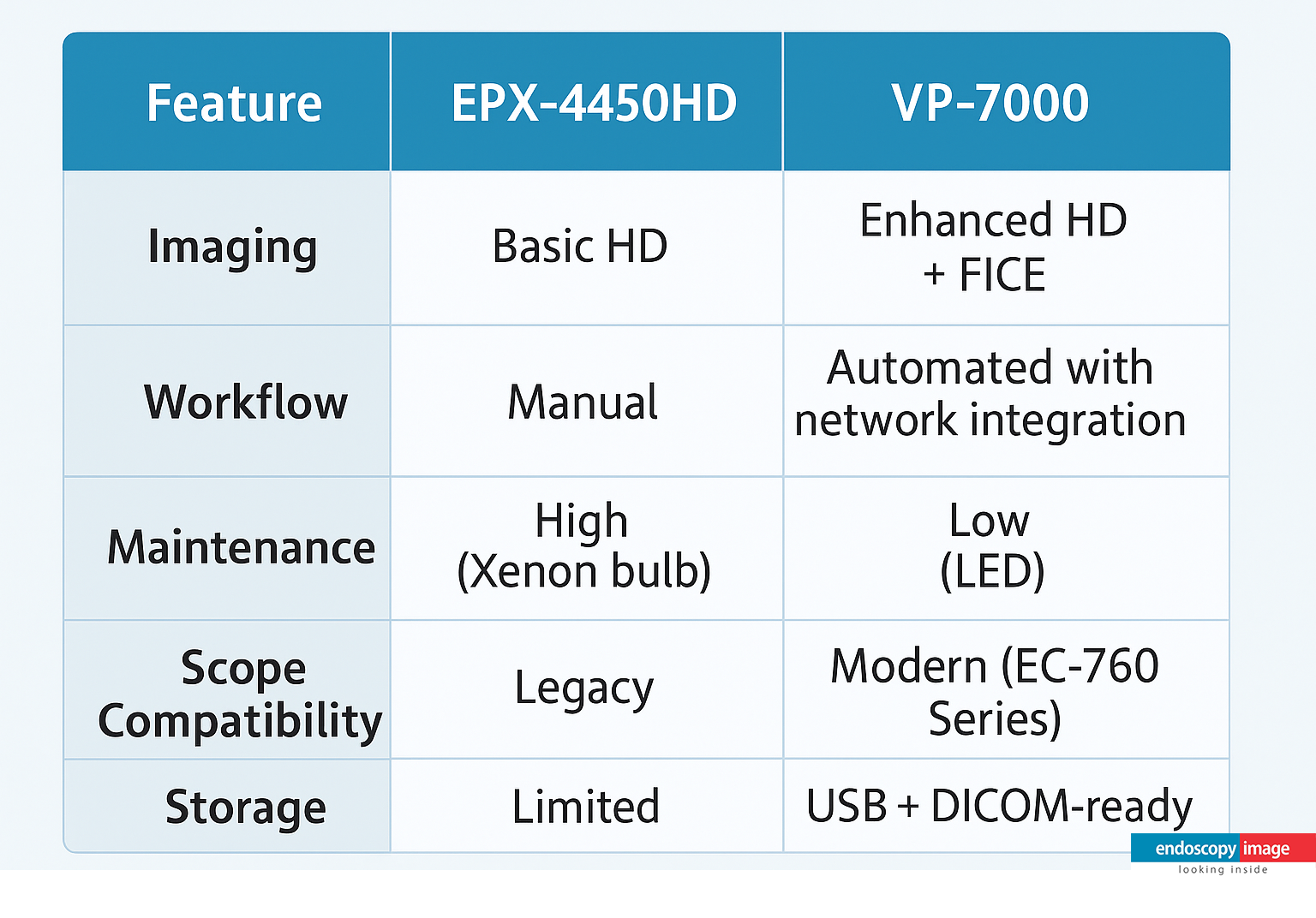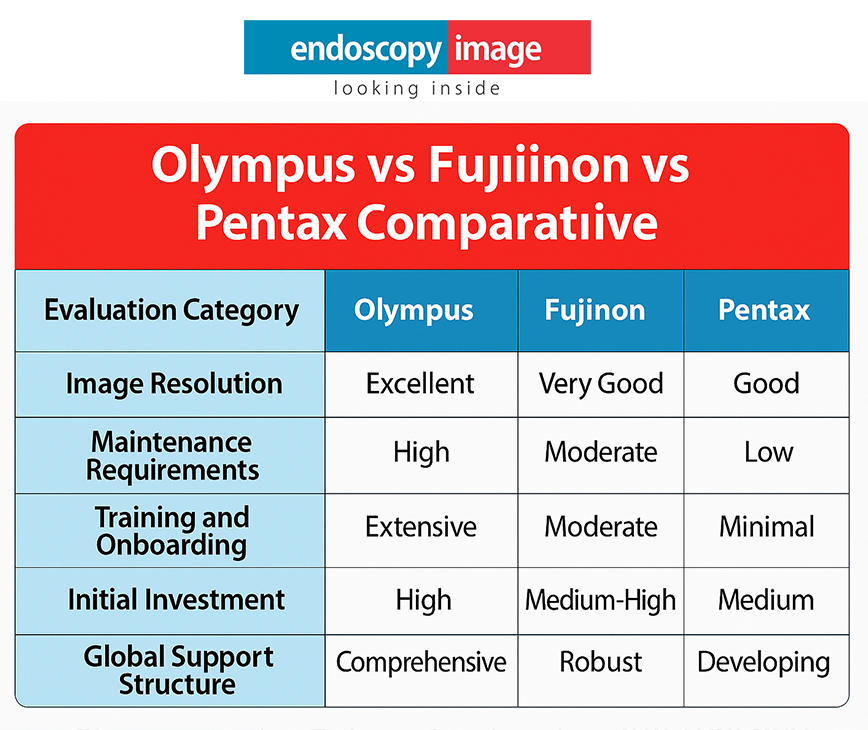Endoscopy Equipment in Mexico and Latin America: Your Complete 2025 Buying Guide
Discover the key differences between endoscopy and colonoscopy procedures. Expert guide for medical..
+1 (786) 681-5247
admin
July 11, 2025

When investing in endoscopic systems, every detail counts. The evolution from the Fujinon EPX-4450HD to the newer VP-7000 platform represents more than a spec upgrade—it’s a leap in performance, diagnostics, and patient care.
In this detailed comparison, you’ll find exactly how the VP-7000 differs from the EPX-4450HD, what real-world benefits it brings to the table, and whether it’s the right time to upgrade your clinic’s endoscopy workflow. From scope compatibility to image processing enhancements, we’ll walk you through everything you need to know.
Whether you’re a gastroenterologist, clinic director, or hospital procurement officer, this guide was written to simplify your decision-making process and help you confidently choose the platform that aligns with your needs.
EPX-4450HD: Delivers traditional HD output with standard digital signal processing. No advanced image enhancement.
VP-7000: Offers enhanced HD imaging with FICE (Flexible Spectral Imaging Color Enhancement) and Multi Zoom. Improved clarity, contrast, and surface detail recognition.
Insight: The VP-7000 enables more accurate mucosal visualization during upper GI and colonoscopic procedures.
EPX-4450HD: Xenon light source or optional LED.
VP-7000: Fully integrated LED light engine with intelligent brightness control. Reduces maintenance cost and increases lifespan.
EPX-4450HD: Traditional interface with limited network or PACS integration.
VP-7000: Modern workflow support with DICOM compatibility, network integration, and USB/SD storage.
⚙️ The VP-7000 improves clinical throughput and reduces documentation errors through automation features.
EPX-4450HD: Compatible with older 4400 and 530 series scopes.
VP-7000: Fully compatible with the latest EC-760ZP-V/L and EC-760R-V/L HD scopes, enabling full system potential.
Enhanced digital noise reduction on VP-7000
Intelligent color correction
Real-time zoom and edge enhancement filters
These upgrades contribute to higher detection rates and faster procedures, especially during colorectal screenings.

✅ VP-7000 reduces long-term costs while offering future-proof flexibility.
Faster start-up and shutdown times
Easier cleaning and disinfection protocols
Standardized settings for different procedures
Clinics with high patient turnover benefit most from the VP-7000 due to reduced lag, seamless data transfers, and intuitive user interface.
If your practice is handling a growing number of procedures, requires precise lesion detection, or needs better integration with modern hospital systems, the VP-7000 is a strong contender.
However, the EPX-4450HD still holds value for smaller practices with lower volume, and limited upgrade budgets.
Choosing between the Fujinon EPX-4450HD vs VP-7000 comes down to balancing budget, performance needs, and long-term goals. If you’re looking for cutting-edge diagnostics, enhanced imaging, and workflow automation, the VP-7000 is the next logical step.

➡️ The VP-7000 offers advanced HD imaging with FICE, LED light source, modern scope compatibility, and digital integration. In contrast, the EPX-4450HD delivers basic HD imaging without image enhancement or workflow automation.
➡️ The VP-7000 is designed to work best with the latest Fujinon 700 series scopes (like EC-760), but also supports some backward compatibility. However, to unlock the full image quality and zoom capabilities, the newest scopes are recommended.
➡️ No. The VP-7000 uses an integrated LED light source, which significantly reduces maintenance costs compared to the Xenon bulbs used in the EPX-4450HD. It also has improved heat management and a longer lifespan.
➡️ It depends on your volume and need for image precision. Small clinics with basic diagnostic needs might still benefit from the EPX-4450HD, but the VP-7000 is ideal if you aim to improve detection rates, workflow automation, and long-term ROI.
➡️ Yes. The VP-7000 supports full DICOM integration and allows seamless communication with PACS systems, making it suitable for hospitals and clinics looking to digitize and centralize imaging data.
After comparing the Fujinon EPX-4450HD vs VP-7000, it’s clear that the VP-7000 brings substantial improvements in imaging, scope compatibility, and digital workflow efficiency.
If you’re a clinic owner, gastroenterologist, or procurement specialist, now is the time to evaluate your equipment’s impact on diagnostics, patient outcomes, and operational flow.
👉 Get a personalized recommendation based on your current system.
👉 Schedule a virtual demo of the VP-7000 in action.
👉 Talk to an expert from Endoscopy Image now and make an informed investment that will benefit your patients and your team.
Discover the key differences between endoscopy and colonoscopy procedures. Expert guide for medical..
Discover the key differences between endoscopy and colonoscopy procedures. Expert guide for medical..
Discover the main types of scopes used in endoscopy and their purposes. Learn..
Unlock the power of DICOM in endoscopy: Learn how this critical standard revolutionizes..
Deprecated: File Theme without comments.php is deprecated since version 3.0.0 with no alternative available. Please include a comments.php template in your theme. in /home/endoscop/public_html/wp-includes/functions.php on line 6131